Search
Search for "click":
(Click here to search this entire website for "click" with Google.)
 |

|
|
PROTO click is an accessory board in the mikroBUS form factor. It features a 10x11 prototyping area as well as additional power pads. It can be used to assemble custom electronics thus creating a custom "click" board. The board provides 3.3V and 5V power supply. PROTO click is a cheap and effective solution for creating click board of your own design. Add sensors, drivers, passive components and make the click board which suits your project needs. Use it with all your favorite development boards which carry mikroBUS sockets. |
|
|
|
 |
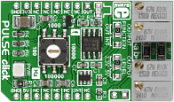
|
|
PULSE click is a pulse generator with an adjustable frequency. It carries the NE555 precision timer capable of producing highly accurate time delays. The frequency of PULSE click is configured in two steps. First select between four frequency bands by using the frequency selector - a circular central switch in the middle of the board. Starting from the six-o-clock position and moving counter-clockwise in quarters, it has 4 options: 0) Up to 100 Hz; 1) Up to 1 kHz; 2) Up to 10 kHz; and 3) Up to 100 kHz. After you select the appropriate position, use the onboard potentiometer to fine-tune the desired output frequency. The resulting output can be configured either as a digital output (communicating with the MCU through the mikroBUS OUT pin) or an interrupt (INT pin). The board is designed to use either a 3.3V or a 5V power supply. |
|
|
|
 |
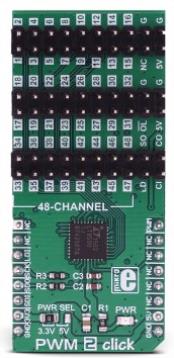
|
|
PWM 2 click offers 48 independently controlled PWM channels, available over the onboard headers, perfectly suited for driving LEDs. Each channel has a 12-bit PWM register associated to it, with the addition of the 6-bit correction register, also known as the dot correction register. PWM 2 is able to detect both synchronization errors and open LED errors, signaling the error via the dedicated pin and the status frame. The Click board™ fully supports cascading, exposing all the necessary pins on the onboard headers, so it can support a large array of LED elements. |
|
|
|
 |

|
|
RELAY Click board features two G6D1AASI-5DC power PCB relay modules as well as two screw terminals. It communicates with the target microcontroller via mikroBUS PWM (RL1) and CS (RL2) pins. A green LED diode indicates the presence of power supply. Controls up to 5A, 250V AC/30V DC loads. The board is designed to use a 5V power supply only, however communication lines voltage level can be in the range of 1.8V to 5V as on-board transistors are used to drive the relays by current sinking. |
|
|
|
 |
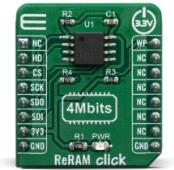
|
|
ReRAM Click features ReRAM (Resistive Random Access Memory) module which contains the cell array made of 524.288 words x 8 bits, which totals 4 Mbits of data. The used memory module can withstand a large number of write cycles, it has data retention period greater than 10 years and it can read and write to random addresses with no delay. Besides these features that already mark this kind of memory modules a milestone in memory manufacturing technology, the device features block write protection, low power consumption and fast SPI interface that can theoretically work up to 5MHz. Because of its universal memory characteristics, ReRAM click can be used both as a non-volatile storage media, or temporary RAM expansion for storing variables in any embedded application.
ReRAM click is supported by a mikroSDK compliant library, which includes functions that simplify software development. This Click board™ comes as a fully tested product, ready to be used on a system equipped with the mikroBUS™ socket.
|
|
|
|
 |
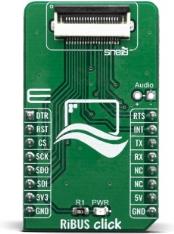
|
|
RiBUS Click is an adapter Click board™ that allows a mikroBUS™ to interface with RiBUS compatible display modules. RiBUS is the intelligent display BUS, by Riverdi, supported by a wide range of Intelligent Display Modules equipped with powerful graphics processors. Their displays allow graphical objects control by exchanging specifically formatted messages with the external microcontroller (MCU). By utilizing the RiBUS click, it is possible to develop an MCU firmware application that can interact with the graphic objects on the Riverdi Display Module over the mikroBUS™. This significantly simplifies the application design, while reducing the processing load on the host MCU, allowing amazing graphically based applications to be created, even with slower 8bit MCUs.
RiBUS click is supported by a mikroSDK compliant library, which includes functions that simplify software development. This Click board™ comes as a fully tested product, ready to be used on a system equipped with the mikroBUS™ socket.
|
|
|
|
 |

|
|
RS232 click is a simple solution for adding RS232 connectivity to your design. RS232 is a serial communications standard mostly used for industrial machines, networking equipment and scientific instruments, as well as for computer peripherals. The board features a standard RS232 DB9 port and a MAX3232 IC, along with a mikroBUS host socket, three jumpers and a power indicator LED. RS232 click communicates with the target board via mikroBUS RX (RXD), TX (TXD), CS (RTS), and INT (CTS) lines. RS232 click is designed to use either a 3.3V or 5V power supply. |
|
|
|
 |
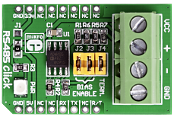
|
|
RS485 Click is an accessory board in mikroBus form factor. The on-board SN65HVD12 (3.3V) or ADM485 (5V) differential line transceiver is suitable for high speed bidirectional data communication on multipoint bus transmission lines. It is designed for balanced data transmission and complies with EIA standards RS-485 and RS-422. This transceiver features a differential line driver and differential line receiver. |
|
|
|
 |
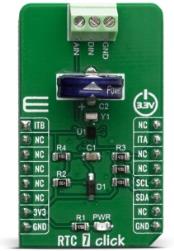
|
|
RTC 7 Click is a real time clock module which has an extremely low power consumption, allowing it to be used with a single button cell battery or a super capacitor, for an extended period of time. The MAX31341B IC built on the RTC 7 click is able to output the time in the binary coded decimal (BCD) format. Integrated, factory calibrated XTAL operating at 32.768 kHz ensures a very low time deviation. However, the RTC 7 click has the onboard external, more precise crystal oscillator too. An advanced interrupt feature allows many different uses such as alarm function, countdown timer function, external event detection function, using an analog and the digital inputs and much more.
RTC 7 click is supported by a mikroSDK compliant library, which includes functions that simplify software development. This Click board™ comes as a fully tested product, ready to be used on a system equipped with the mikroBUS™ socket.
|
|
|
|
 |
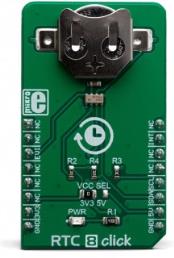
|
|
RTC 8 click is a real time clock module which has an extremely low power consumption, allowing it to be used with a single button cell battery, for an extended period of time. The RV-3028-C7 module built on the RTC 8 click is able to output the time in the standard format, as well as in the 32-bit UNIX format. Integrated, factory calibrated XTAL operating at 32.768 kHz ensures a very low time deviation. The compensation and offset data are stored within the internal non-volatile memory. There is also a possibility to password-protect the configuration parameters. An advanced interrupt feature allows many different uses such as alarm function, countdown timer function, external event detection function with time stamp and much more.
RTC 8 click is supported by a mikroSDK compliant library, which includes functions that simplify software development. This Click board™ comes as a fully tested product, ready to be used on a system equipped with the mikroBUS™ socket.
|
|
|
|
 |
|
<< First
< Previous
Next >
|
|

